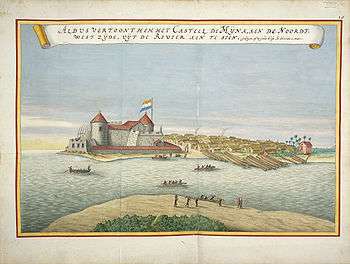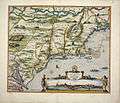Laurens van der Hem
Laurens van der Hem (1621 – 1678), was a Dutch lawyer and a collector of maps and landscape prints. He is known today for his meticulously thorough version of the Atlas Maior, itself a major work of art by his friend Joan Blaeu.
Biography
He was born in Amsterdam as the son of the lawyer Ysbrand van der Hem and Geertrui Spiegel, the daughter of the poet Hendrik Laurenszoon Spiegel. His uncles on his father's side were famous; his uncle Herman was a gifted draughtsman, his uncle Hendrik became a lawyer who acquired a large library, and his uncle Arend was knighted by Ferdinand II, Holy Roman Emperor in 1620, and called himself Jonker Arnold van der Hem, Ridder, Heer van Nedersteyn, Corl en Hilteprant.[1]
According to the RKD he travelled in Italy, and on his return married and settled on the Herengracht. There he collected the material he used to supplement his personal copy of the Atlas Maior, that is known today as the "Eugenius-atlas", or Atlas Blauw-van der Hem, today in Austria.[2]
Blaeu's Atlas Maior of the whole world

The Atlas Maior was popular in Amsterdam when it was published in installments starting in 1649 (last volume in 1673) in 11 gold-embossed volumes. To save money, collectors could purchase it plain without handpainted embellishments. Laurens van der Hem went a step further and ordered his maps unbound, and proceeded to have Blaeu's best map-finisher color them in, Dirk Jansz van Santen.[3] The eleven volumes of the Blaeu maps form the body of the work, but include a volume of "secret maps" of the VOC that were never part of the original publication. The entire collection is 46 volumes with 4 supplements and a portfolio of loose maps, which together include over 2400 full color maps and drawings of ports, towers, and landscapes by artists such as Andries Beeckmann, Gaspar Bouttats, Jan Peeters I, Bonaventura Peeters the Elder, Jacques Callot and Cornelis Gerritsz Decker.[4] Some artists who travelled and brought back drawings of their travels had their work included, such as Lambert Doomer, Jan Hackaert, Adriaen Matham, Roelant Savery, Willem Schellinks, and Reinier Nooms, also named as 'Zeeman'.[2] Southwest France was drawn by Laurens' brother Herman, who died a bachelor in Bordeaux. Drawings of Italy and Sicily were described by Laurens himself.
Curiosity cabinet
The map collection became something of a tourist attraction, and Cosimo III de' Medici, Grand Duke of Tuscany paid a visit to the Herengracht to view it on 2 January 1668.[5] On 9 March 1711, the German travelling scholar Zacharias Conrad von Uffenbach paid a visit to Laurens' daughter Agatha (Jungfer van der Gemm) to view her Blauischen Atlas, for which the Comte d'Avaux had offered her 20,000 guilders, but which she valued at 50,000 guilders.[6] Conrad von Uffenbach was highly impressed by the coloring done by the master "Dirck Janssen van Santen".
Eugenius atlas
After Agnes van der Hem's death in 1712, a grandson of Laurens sold it in 1730 to Prince Eugene of Savoy, stadholder in the Southern Netherlands for 22,000 florins. It afterwards came to be known as the Eugenius-atlas. It is in the collection today of the National library of Austria in Vienna.[2]
 Puerto Rico
Puerto Rico El Mina, Ghana
El Mina, Ghana New Netherland, with New England
New Netherland, with New England
The atlas was nearly lost in a fire in 1992 and has since been digitised and added to the UNESCO list of World Heritage in 2003.[5][7] In 2011 a facsimile project was completed.[8]
| Wikimedia Commons has media related to Laurens van der Hem. |
References
- ↑ Arnold van der Hem in the Montias database
- 1 2 3 Laurens van der Hem in the RKD
- ↑ Dirk Janszoon van Santen in the RKD
- ↑ Atlas Blaeu-Van der Hem at Brill
- 1 2 Website about the facsimile project
- ↑ Visit 9 March 1711 in Zacharias Conrad von Uffenbach's diary on Google books
- ↑ Registered heritage page of the Atlas Blaeu-Van der Hem in the Austrian National Library on UNESCO website
- ↑ Website of the facsimile project with several full color pictures
External links
- Dutch documentary on the Atlas Blauw-van der Hem
- "Makian As It Appears from the Side of Ngofakiaha" with biographical information about van der Hem